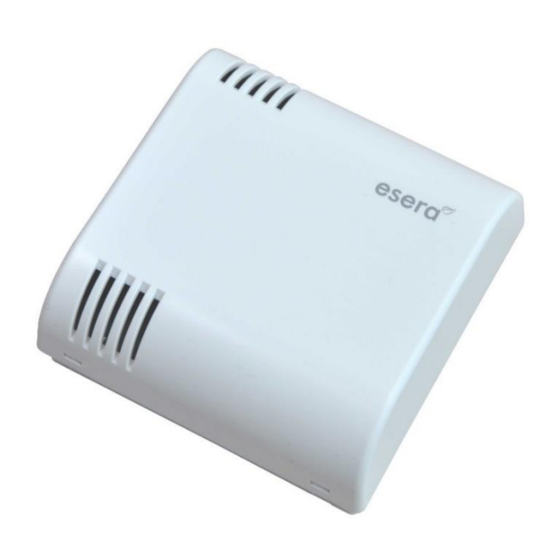esera automation 11150 Manual do utilizador - Página 6
Procurar online ou descarregar pdf Manual do utilizador para Acessórios esera automation 11150. esera automation 11150 7 páginas. 1-wire multisensor pro for temperature and air humidity

-
Total cable length and cable type
-
Number of 1-Wire devices
-
Type of cable installation (topology)
-
Number and design of cable connectors (unnecessary connection transitions should be avoided)
All factors in total are summarised and referred to as 1-Wire Bus load. Each increase of a factor increases the
total 1-Wire Bus load for the 1-Wire controller and thus reduces the maximum network size.
According to our many years of experience and a lot of feedback from customers, the following conservative
recommendation can be made:
-
Maximum cable length 50 -120m
-
Number of 1-Wire devices no more than 20 -22 pieces
-
As linear a topology as possible without T-junctions
The topology in particular plays a major role. If possible, linear topology should be used. The linear topology can
be compared like pearls on a pearl necklace. The data line should be laid from one device to the next without
T-joints.
Furthermore, the type of cable used can also be mentioned here. We recommend for the cabling
CAT5 or CAT6 network cable. It is also possible to use J-Y(St)Y telephone cables and KNX cables. Longer cable
runs are possible with CAT5 versus CAT7 cables.
With twisted pair cables, a longer connection length can be achieved in an undisturbed environment, as the
capacitive bus load is lower. A total length of 50 m and more can be easily achieved without additional measures.
In disturbed, commercial and industrial environments, the cable should always be shielded in order to increase
the "robustness" or interference sensitivity of the system
Note
The above statements about 1-Wire are hints and tips and do not describe any product property or
represent any warranted product property of the product and the 1-Wire Controller.
1-Wire Controller dar.
15
Operating conditions
The Multisensor is designed for temperature and humidity measurements of air and gases indoors, such as
living spaces, offices, workshops or public facilities. The measured values given under technical data are
limit data for the entire 1-Wire Multisensor and must not be undershot or exceeded, otherwise the sensor
may be damaged.
16
Disposal note
Do not dispose of the device within the household waste! According to the directive
concerning old electrical and electronic appliances, electronic devices must be disposed of
via the collecting points for old electronic appliances!
17
Safety instructions
When using products that come into contact with electrical voltage, the valid VDE regulations must be
observed, especially VDE 0100, VDE 0550/0551, VDE 0700, VDE 0711 and VDE 0860
All final or wiring work must be carried out with the power turned off.
Before opening the device, always unplug or make sure that the unit is disconnected from the mains.
Components, modules or devices may only be put into service if they are mounted in a contact proof housing. During
installation they must not have power applied.
Tools may only be used on devices, components or assemblies when it is certain that the devices are disconnected
from the power supply and electrical charges stored in the components inside the device have been discharged.
Live cables or wires to which the device or an assembly is connected, must always be tested for insulation faults or
breaks.
If an error is detected in the supply line, the device must be immediately taken out of operation until the faulty cable
has been replaced.
When using components or modules it is absolutely necessary to comply with the requirements set out in the
accompanying description specifications for electrical quantities.
If the available description is not clear to the non-commercial end-user what the applicable electrical characteristics for
a part or assembly are, how to connect an external circuit, which external components or additional devices can be
connected or which values these external components may have, a qualified electrician must be consulted.
It must be examined generally before the commissioning of a device, whether this device or module is basically
suitable for the application in which it is to be used.
In case of doubt, consultation with experts or the manufacturer of the components used is absolutely necessary.
For operational and connection errors outside of our control, we assume no liability of any kind for any resulting
damage.
All rights reserved. Reproduction as well as electronic duplication of this user guide, complete or in part, requires the written consent of
ESERA GmbH. Errors and technical modification subject to change. ESERA GmbH 2021
www.esera.de
11150 V3.0 R1.0 Manual
Page 6 of 7
